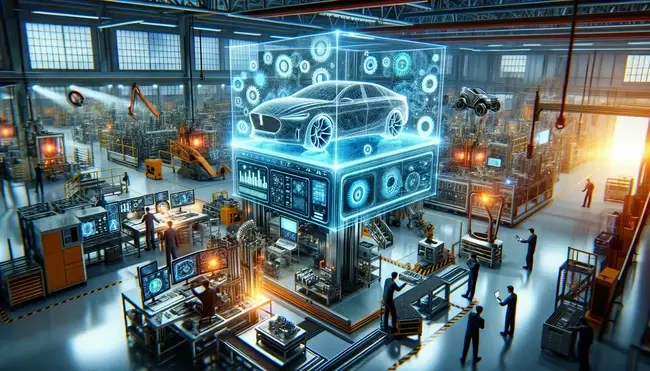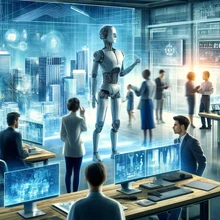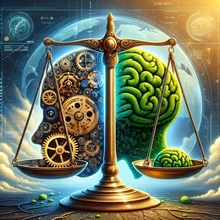
Artificial Intelligence (AI) has become an integral part of the new product design process for manufacturers. Its role is multifaceted and evolving, offering various benefits that streamline and enhance the design process. In manufacturing product design, different types of Artificial Intelligence (AI) are employed to enhance various aspects of the design process, improve efficiency, and create innovative products. The primary AI types utilized include machine learning, deep learning, natural language processing (NLP), and computer vision, among others. Here's how each type contributes to the process:
Machine Learning (ML)
-
Predictive Analysis: Machine learning algorithms analyze historical data to predict future trends, which helps in designing products that cater to future market demands.
-
Optimization: ML models optimize product designs for various parameters like material usage, cost, and performance efficiency.
-
Quality Control: ML algorithms can predict potential defects or quality issues in product designs before they go into production.
-
Customization: ML enables the creation of personalized products by analyzing customer data and preferences.
Deep Learning (DL)
-
Image and Pattern Recognition: Deep learning, particularly convolutional neural networks, is used for image analysis in design. It can recognize patterns and features in design elements that correlate with performance or aesthetic appeal.
-
Generative Design: Deep learning algorithms can generate new product designs by learning from a dataset of existing designs, offering innovative and efficient design alternatives.
-
Simulation and Testing: DL models simulate and test various design scenarios, providing insights into how a product will perform under different conditions.
Natural Language Processing (NLP)
-
Requirement Analysis: NLP can analyze customer feedback, market reports, and product reviews to extract insights and requirements for new products.
-
Collaborative Design: Facilitates better communication and collaboration among diverse teams involved in product design by interpreting and synthesizing verbal and written inputs.
Computer Vision
-
Design Validation: Computer vision systems can compare designed products against predefined standards or check for defects.
-
Augmented Reality (AR) in Design: Integrating AR with computer vision allows designers to visualize products in real-world scenarios, aiding in spatial and ergonomic design considerations.
Reinforcement Learning
-
Automated Decision-Making: In scenarios where multiple design options are available, reinforcement learning helps in making decisions based on the success of previous iterations.
-
Robotics in Design: Used for automating certain parts of the design process, especially in creating physical prototypes.
Robotics and Automation
-
Prototype Development: Robots, powered by AI, can assist in rapidly developing and testing physical prototypes.
-
Interactive Design: Some advanced systems use AI-driven robots to interact with designers, providing physical feedback during the design process.
Expert Systems
-
Knowledge-Based Design: Expert systems store knowledge and best practices in product design, guiding designers through the process and ensuring compliance with industry standards.
Design Process with AI
Here are some of the ways manufacturers are using AI in new product design:
-
Market Analysis and Trend Prediction: AI tools analyze large datasets, including market trends, consumer behaviors, and social media patterns, to predict future trends. This information helps designers in creating products that are more likely to meet market demands and consumer preferences.
-
Concept Development and Idea Generation: AI algorithms, often based on techniques like natural language processing and machine learning, can assist in generating new product ideas. They can analyze existing products, patents, and scientific papers to suggest novel concepts or improvements.
-
Design Optimization: AI systems use advanced algorithms to optimize designs for various factors like efficiency, cost, materials, and environmental impact. For example, in engineering design, AI can simulate and evaluate multiple iterations to find the most effective design solution.
-
Customization and Personalization: AI enables the creation of customized and personalized products by analyzing individual customer data. Manufacturers can use AI to design products that cater to specific consumer preferences or needs, enhancing the user experience.
-
Rapid Prototyping: AI, combined with technologies like 3D printing, accelerates the prototyping phase. AI algorithms can quickly generate prototype designs, test them in virtual environments, and make adjustments before any physical model is built.
-
Supply Chain Integration: AI assists in integrating the design process with supply chain management. It can predict and plan for the materials needed, optimize inventory levels, and ensure that the design is feasible from a manufacturing perspective.
-
Enhanced Collaboration: AI tools facilitate better collaboration among designers, engineers, and other stakeholders. AI-powered platforms can consolidate inputs from various sources, track changes, and ensure all parties are updated on the design process.
-
Predictive Maintenance and Lifecycle Analysis: AI can predict the maintenance needs and lifecycle of a product even during the design phase. This helps in designing products that are more durable, easier to maintain, and have a longer lifespan.
-
Sustainability and Eco-friendly Design: AI aids in creating sustainable and eco-friendly products by analyzing materials, energy efficiency, and environmental impact. It can suggest alternative materials or design modifications to make products more environmentally friendly.
-
Feedback Incorporation: Post-launch, AI tools can analyze customer feedback and performance data to suggest design improvements for future iterations or models.
-
Compliance and Safety Checks: AI systems can ensure that designs comply with industry standards and safety regulations by automatically checking designs against regulatory requirements.
The Role of Digital Twins in Product Design
Digital twins are virtual replicas of physical devices, systems, or processes. They are created by integrating various technologies such as the Internet of Things (IoT), artificial intelligence (AI), machine learning, and software analytics. Digital twins serve as real-time digital counterparts of physical entities and are used for various purposes, including in product design. Here's a detailed explanation of digital twins and their application in product design:
Understanding Digital Twins
-
Creation: A digital twin is developed using data collected from sensors embedded in the physical object. This data might include information about the object's operational status, environmental conditions, and physical properties.
-
Characteristics: These virtual models are dynamic and can update and change as their physical counterparts go through changes. They can simulate real-world conditions and predict future states using AI and analytics.
-
Components: A digital twin typically consists of three components:
-
Data Models: Representing the physical object's properties and behaviors.
-
Information System: Connecting the twin with data sources and analytics tools.
-
Integration Layer: Allowing the twin to communicate with the physical object and other systems.
-
Applications in Product Design
-
Prototyping and Testing: Digital twins enable designers to test and prototype products virtually. This means they can simulate how a product will perform under various conditions without having to build multiple physical prototypes. This not only saves time and resources but also allows for a more extensive range of tests.
-
Performance Analysis and Optimization: By creating a digital twin of a product, designers can analyze its performance in real-time. They can experiment with different design variations in the virtual model to identify the most efficient design, optimize for various factors like durability, efficiency, and user experience.
-
Predictive Maintenance: Digital twins can predict wear and tear on a product, allowing designers to understand how products age and fail. This insight is crucial in designing more durable and maintainable products.
-
Customization and Personalization: They enable designers to create more personalized products by simulating how they would perform for specific user requirements. This is especially useful in industries like healthcare where products like prosthetics need to be highly customized.
-
Lifecycle Management: Digital twins can monitor a product throughout its lifecycle. Designers can use the collected data to make improvements in future iterations of the product.
-
Supply Chain Integration: They can be used to simulate and optimize the manufacturing process, ensuring that the product design is aligned with manufacturing capabilities and supply chain logistics.
-
Sustainability Analysis: Designers can use digital twins to assess the environmental impact of a product throughout its lifecycle, helping in creating more sustainable designs.
-
User Experience and Feedback: Digital twins can simulate how users interact with the product, providing valuable insights into user experience. This data can be used to enhance the design for better usability and customer satisfaction.
Digital twins revolutionize product design by providing a powerful tool for simulation, analysis, and testing. They allow designers to explore more innovative solutions, improve efficiency, reduce costs, and create products that better meet user needs and sustainability goals. As technology advances, the use of digital twins in product design is expected to become more prevalent, further blurring the lines between the physical and digital worlds.
AI in new product design offers a comprehensive set of tools that aid in market analysis, idea generation, design optimization, and much more. This not only speeds up the design process but also ensures that the final products are innovative, efficient, customer-centric, and sustainable.












